Financial Statements 3
For example;
1. 1997 The following Trial balance was prepared from the books of Paka Traders as at 31st December 1995.
Trial balance December 31st 1995
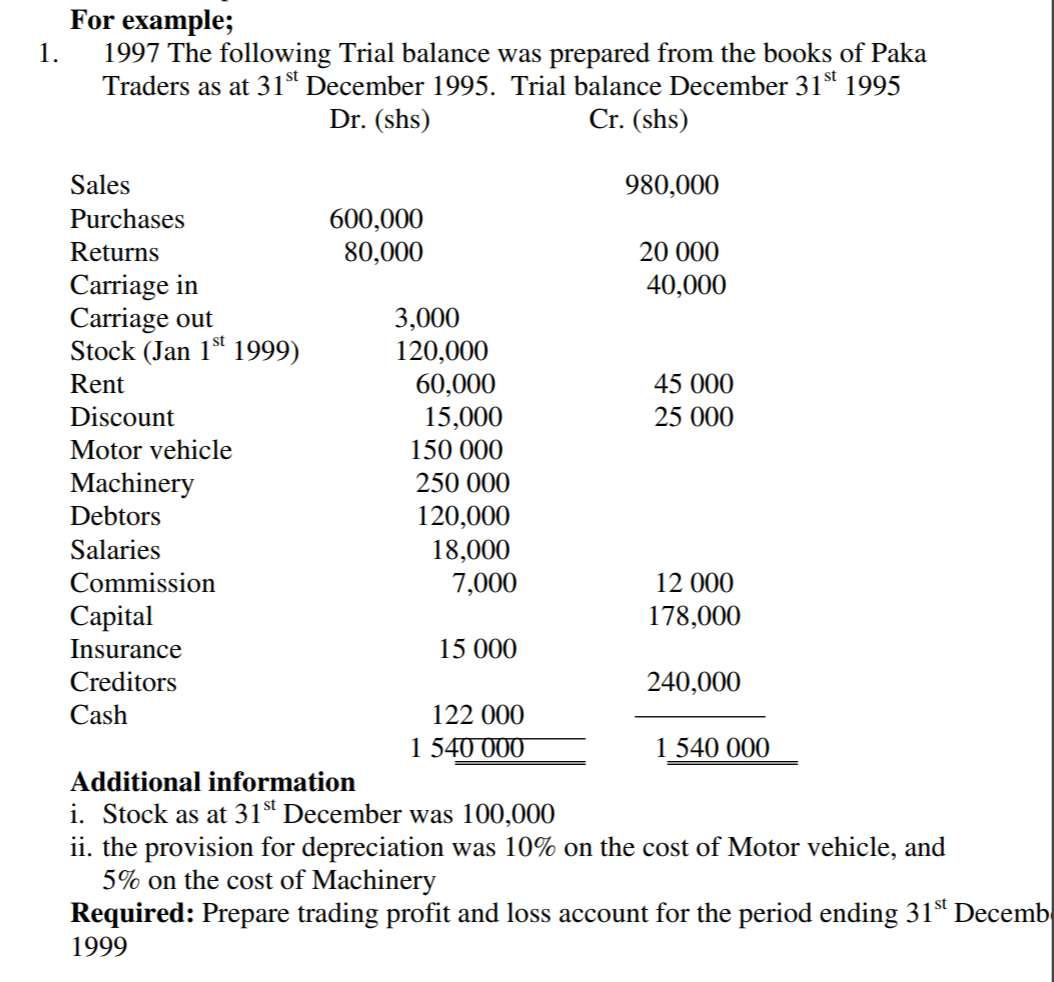
Additional information
i. Stock as at 31st December was 100,000
ii. the provision for depreciation was 10% on the cost of Motor vehicle, and 5% on the cost of Machinery
Required: Prepare trading profit and loss account for the period ending 31st December 1999
Adjustments: Provision for depreciation;
Machinery = 5/100(250 000)= 7 500
(New balance of machinery = 250 000 – 7 500 = 242 500.
The 242 500 is taken to the balance as Machinery (fixed asset), while 7 500 is taken to the trading profit and loss account as expenses)
Motor vehicle = 10/100( 150 000) = 15 000
(New balance of Motor Vehicle = 150 000 – 15 000 = 135 000.
The 135 000 is taken to the balance as Motor Vehicle (fixed asset), while 15 000 is taken to
the trading profit and loss account as expenses)
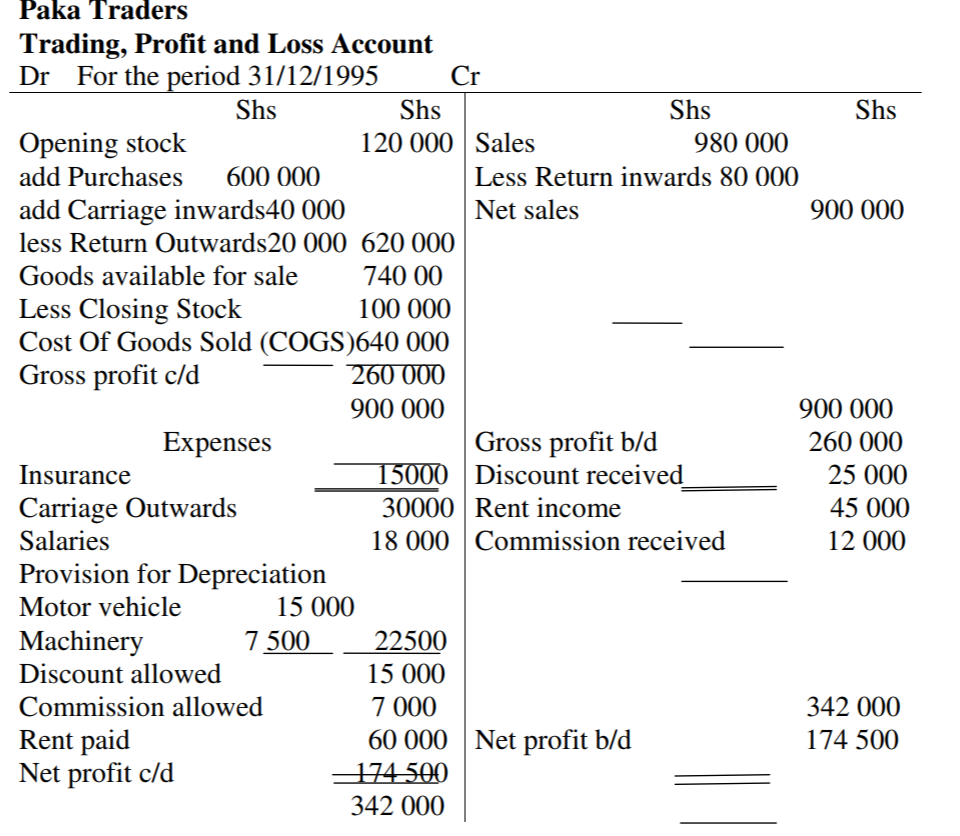
The net profit/loss may be taken to the balance sheet.
The items that have been adjusted will be recorded in the balance sheet less the adjustment.
The Balance Sheet
The balance sheet will show the business financial position in relation to assets, capital and liabilities.
The adjustment that can be made will be on
Fixed assets and capital only.
That is;Fixed assets are recorded less their depreciation value (should there be provision for depreciation) as the actual value.
Actual value of assets = Old value -depreciation.
Capital is adjusted with the following; Net capital, Drawings and additional investment. i.e
Closing Capital/Net capital (C.C) = Opening/initial capital (O.C) + Additional
Investment (I) + Net profit (N.P) or (less Net Loss) – Drawings
CC = OC + I + NP – D
Where:
Opening Capital:
The capital at the beginning of the trading period Closing capital: - the capital as at the end of the trading period
Additional Investment: - any amount or asset that the owner adds to the business during the trading period
Net profit: - the profit obtained from the trading activities during the period.
In case of a loss, it is subtracted.
Types of Capital
The capital in the business can be classified as follows:
Capital Owned/Owner’s Equity/Capital invested;
This is the capital that the owner of the business has contributed to the business. It is the Net capital/Closing capital of the business (C = A – L)
Borrowed capital:
The resources brought into the business from the outside sources.
They are the long term liabilities of the business.
Working capital: These are resources in the business that can be used to meet the immediate obligation of the business.
It is the difference between the total current assets and total current liabilities.
Working Capital = Total Current Assets – Total Current Liabilities
Capital employed:
These are the resources that has been put in the business for a long term. i.e.
Capital Employed = Total Fixed assets + Working Capital Or
Capital employed = Capital Invested + Long term liabilities
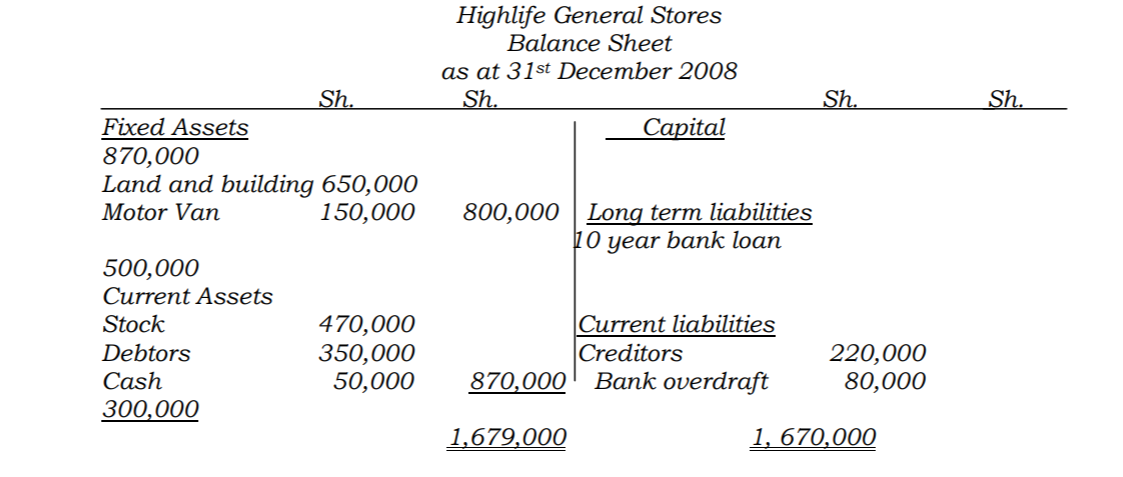
Example 00A: The following information were extracted from the trial balance of Mwema traders on 31st December 2010.
Sales 750 000
Furniture 288 000
Purchases 540 000
Electricity expenses 16 000
Sales return 24 000
Motor vehicle 720 000
Return outwards 30 000
Rent expenses 2 500
General expenses 72 000
Capital 842 500
Commission received 24 000
Bank Loan 250 000
Cash 156 000
Creditors 216 000
Debtors 244 000
Additional Information
a) Stock as at 31/12/2010 was ksh 72 000
b) Electricity prepaid was shs
c) Rent expenses accrued shs 3500
d) Depreciation was provided for as follows
-Motor Vehicle 15% p.a. on cost -Furniture 6% p.a. on cost
Required
(i) Prepare Trading, profit and loss account for the year
(ii) Prepare a balance sheet as at 31st December 2012
(iii) Determine the following:
-Owner’s equity -Borrowed capital -Working capital -Capital employed
Adjustments:
Motor Vehicle = 15/100 (720 000) = 108 000
Therefore Motor vehicle = 612 000
Furniture = 6/100 (288 000) = 17 280
Therefore furniture = 270 720
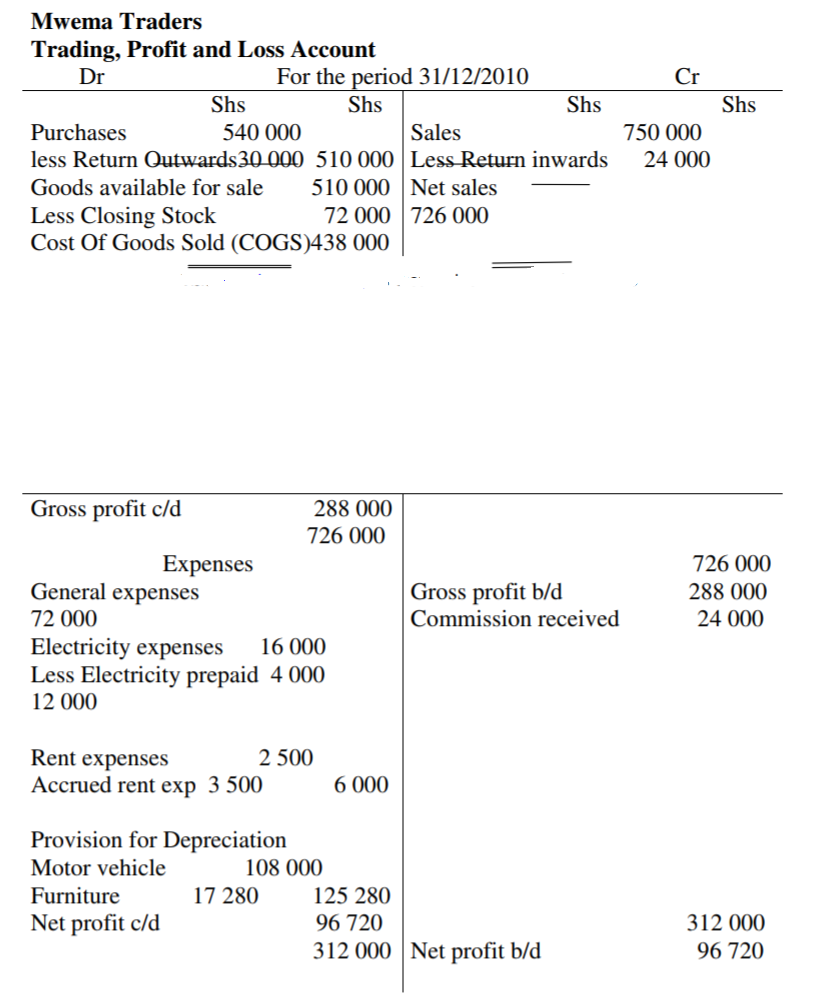
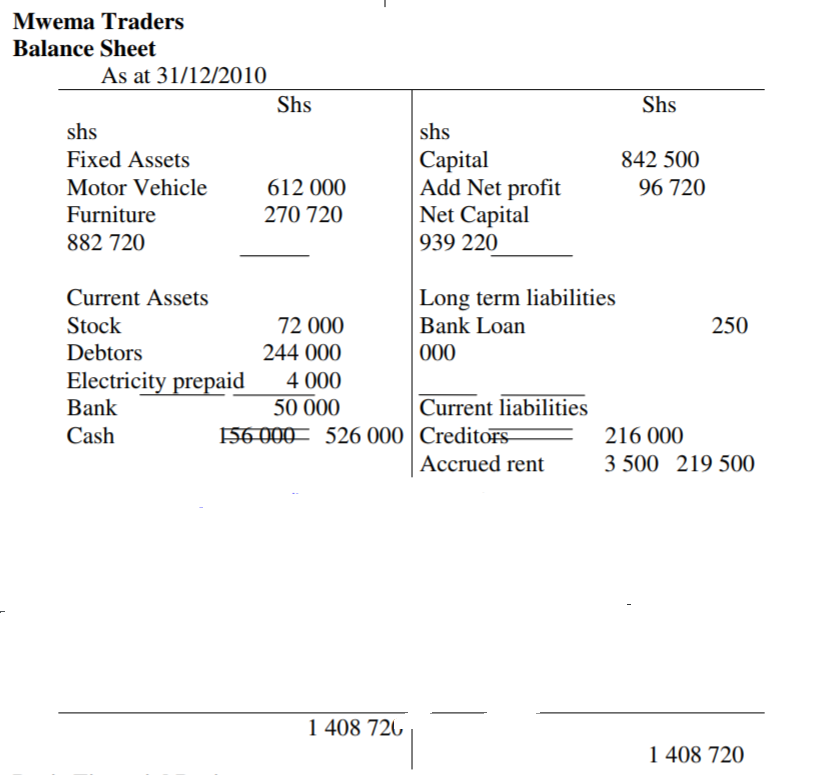
Basic Financial Ratios
A ratio is an expression of one item in relation to the other.
It is used to compare the groups of related items in the business, for the purpose of assessing the performance of the business.
They include:
a) Mark-up
This is the comparison of gross profit as a percentage of cost of goods sold.
i.e.
Mark-up = Gross Profit/Cost of goods sold(100)
For example: in (example OOA) above, determine the mark-up of the business.
For example: in (example OOA) above, determine the mark-up of the business.
Mark-up = GP/COGS(100)
Gross profit = 288 000
COGS = 438 000
Mark-up = GP/COGS(100)
Gross profit = 288 000
COGS = 438 000
288 000/438 000*100
= 65.75%
(This implies that the Gross profit of the business is 65.75% of its cost of goods sold)
b) Margin
This is the expression of the gross profit as a percentage of net sales. That is:
Margin =
For example: in (example OOA) above, determine the margin of the business
Margin = Gross Profit/Net Profit(100)
Gross profit = 288 000
Net sales = 726 000
=288 000/726 000*100
= 39.67%
(This implies that the gross profit of the business is 39.67% of the net sales)
Relationship between margin and mark-up
Since margin and mark-up are all the expression of Gross profit, it is possible to change one to the other.
Changing mark-up to margin
Mark-up can be changed to margin as follows:
(i) Convert the mark-up percentage as a fraction in its simplest form.
(ii) Add the value of the numerator of the fraction to the denominator to come up with the new fraction (margin fraction) that is If the
mark-up fraction = a/n
.
Margin fraction = a/n+a
(iii) Convert the margin fraction as a percentage to obtain margin For example: in the above example,
Mark –up = 65.75%
65.75/100
263/100
Margin fraction = 263/400+263
= 39.67%
Changing margin to mark-up
(i) Convert the margin percentage as a fraction in its simplest form
(ii) Subtract the value of the numerator of the fraction from the denominator to come up with the new fraction (mark-up fraction) that is.
(iii) Convert the mark-up fraction as a percentage to obtain mark-up
For example: in the above example,
If the margin fraction = a/n
Mark-up fraction = a/n-a
(iii) Convert the mark-up fraction as a percentage to obtain mark-up
For example: in the above example
Margin = 39.67%
= 39.67/100
=263/663
Mark-up fraction = 263/663-263
=263/400*100
= 65.75%
c) Current ratio/working capital ratio
This is the ratio of the current assets to current liabilities.
It can also be expressed as a percentage. That is:
Current ratio = current assets/current liabilities
= current assets: current liabilities
or Current ratio =current assets/current liabilities*100
For examples: in (example OOA) above, determine the current ratio;
Current assets = 526 000
Current liabilities = 219 500
Current ratio = current assets/current liabilities
=526 000/219 500 = 1052: 439
=526 000/219 500*100
=239.64%
Financial Statements 1 | Financial Statements 2 |
Financial Statements 3 | Financial Statements 4 |
Scholarship 2026/27
Current Scholarships 2026/2027 - Fully Funded
Full Undergraduate Scholarships 2026 - 2027
Fully Funded Masters Scholarships 2026 - 27
PhD Scholarships for International Students - Fully Funded!
Funding Opportunities for Journalists 2026/2027
Funding for Entrepreneurs 2026/2027
***
